Some pertinent oral communication strategies for efl learning and teaching
To communicate successfully in study and everyday conversations is very
important. Speakers or participants all want to be successful in exchanging
ideas and getting an end result after the dialogue finishes. There are several
popular ways to maintain progress or end a conversation. In this paper,
some relevant strategies are addressed so that thestudents or users of
English as a foreign language (EFL) know what they have done intentionally
or unintentionally through time. The main purpose of this article is to
suggest to educators three strategies used in the field of EFL teaching and
learning such as avoidance, compensation and time gaining. Then, there is a
recommendation to teach or not teach these strategies, or what strategies
should be focused upon and what strategies should be introduced for
discussion only
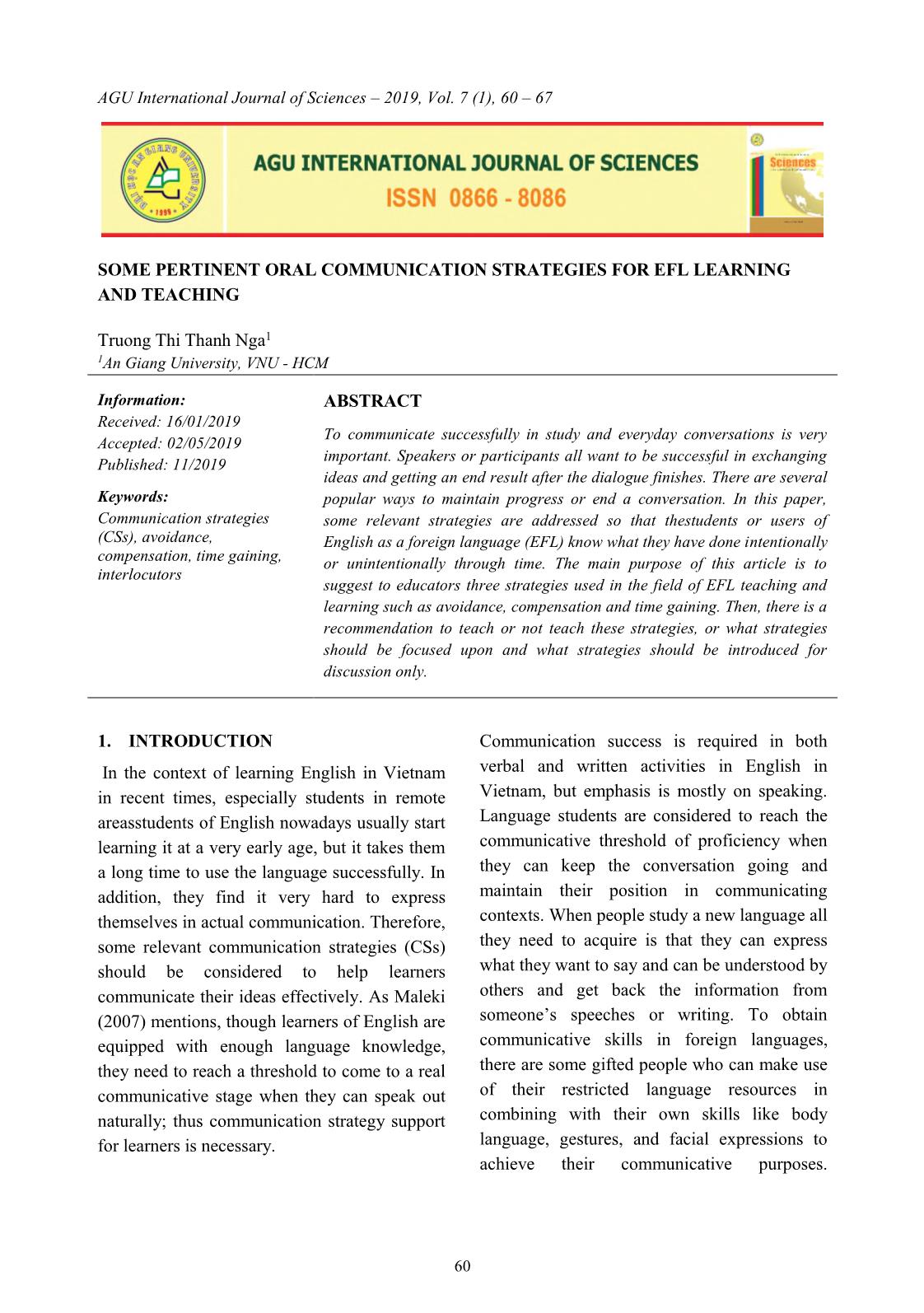
Trang 1
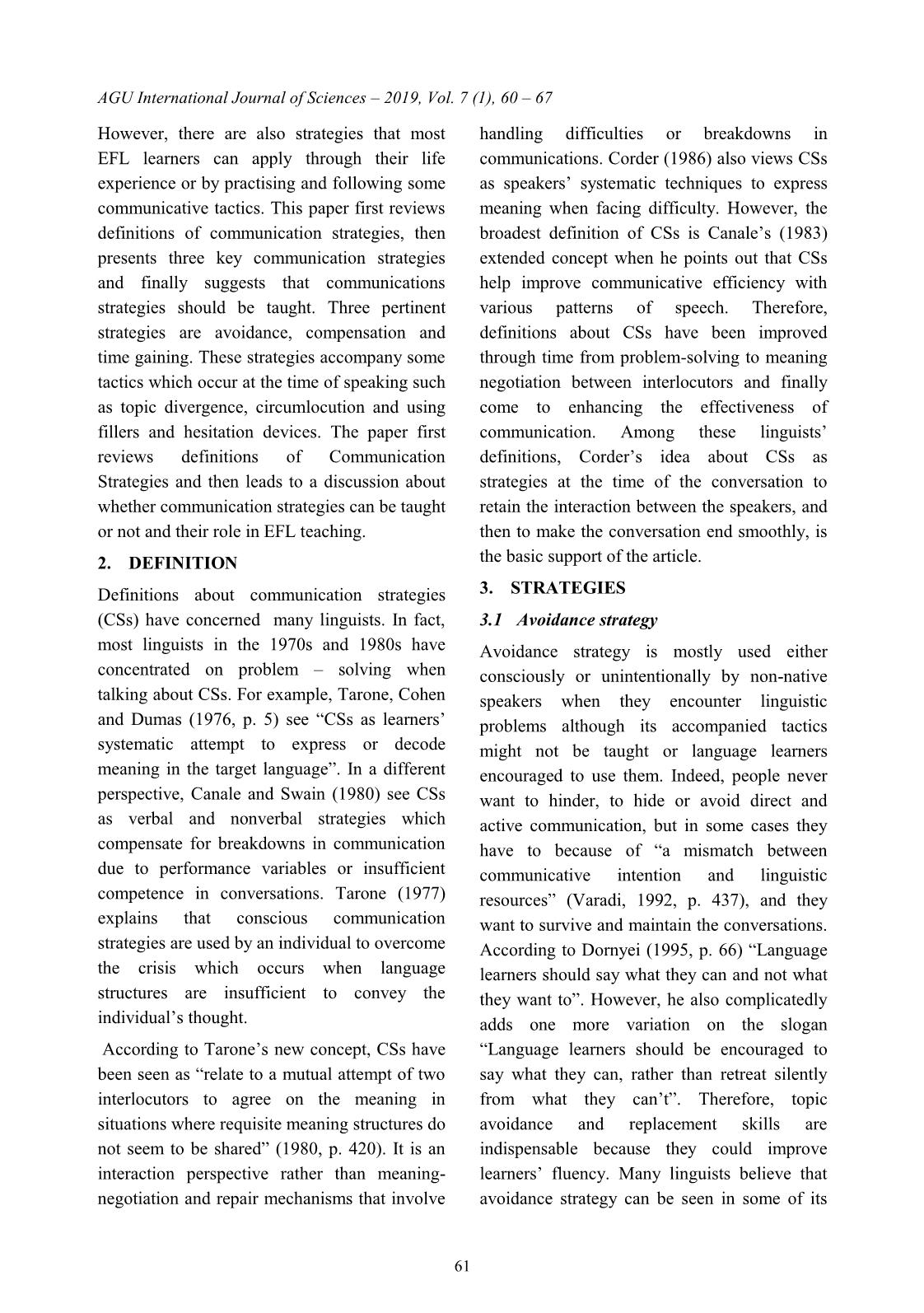
Trang 2
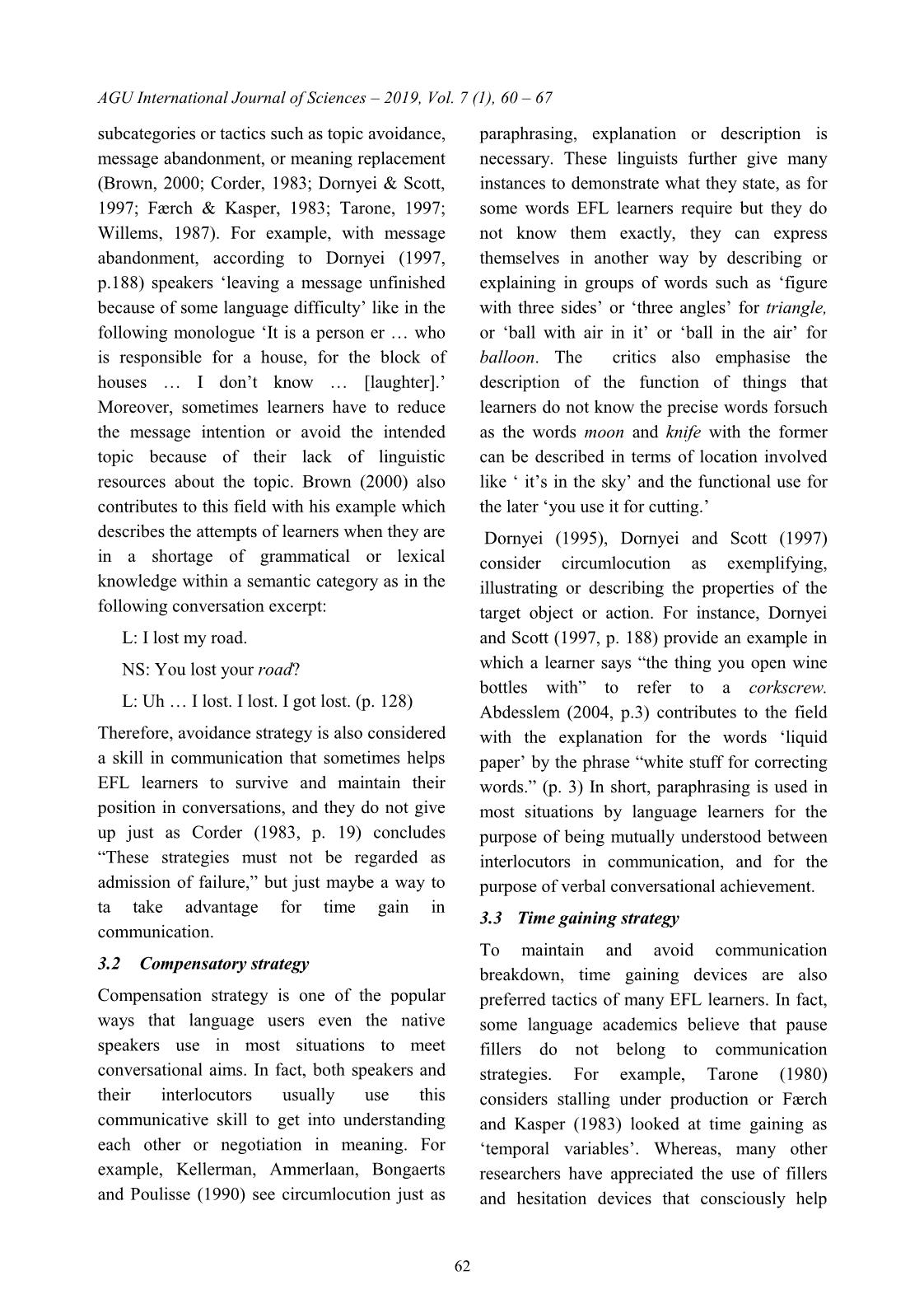
Trang 3
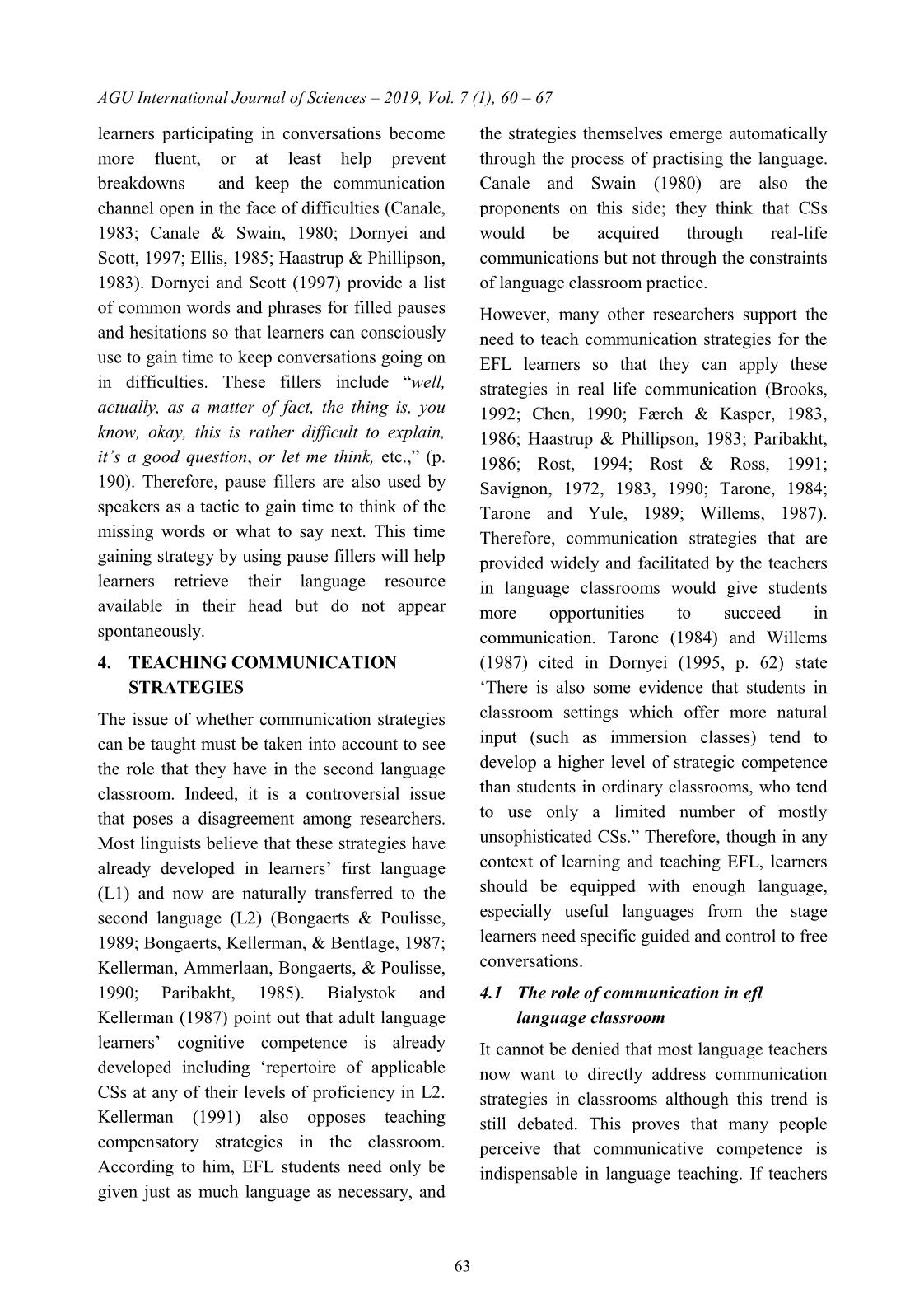
Trang 4
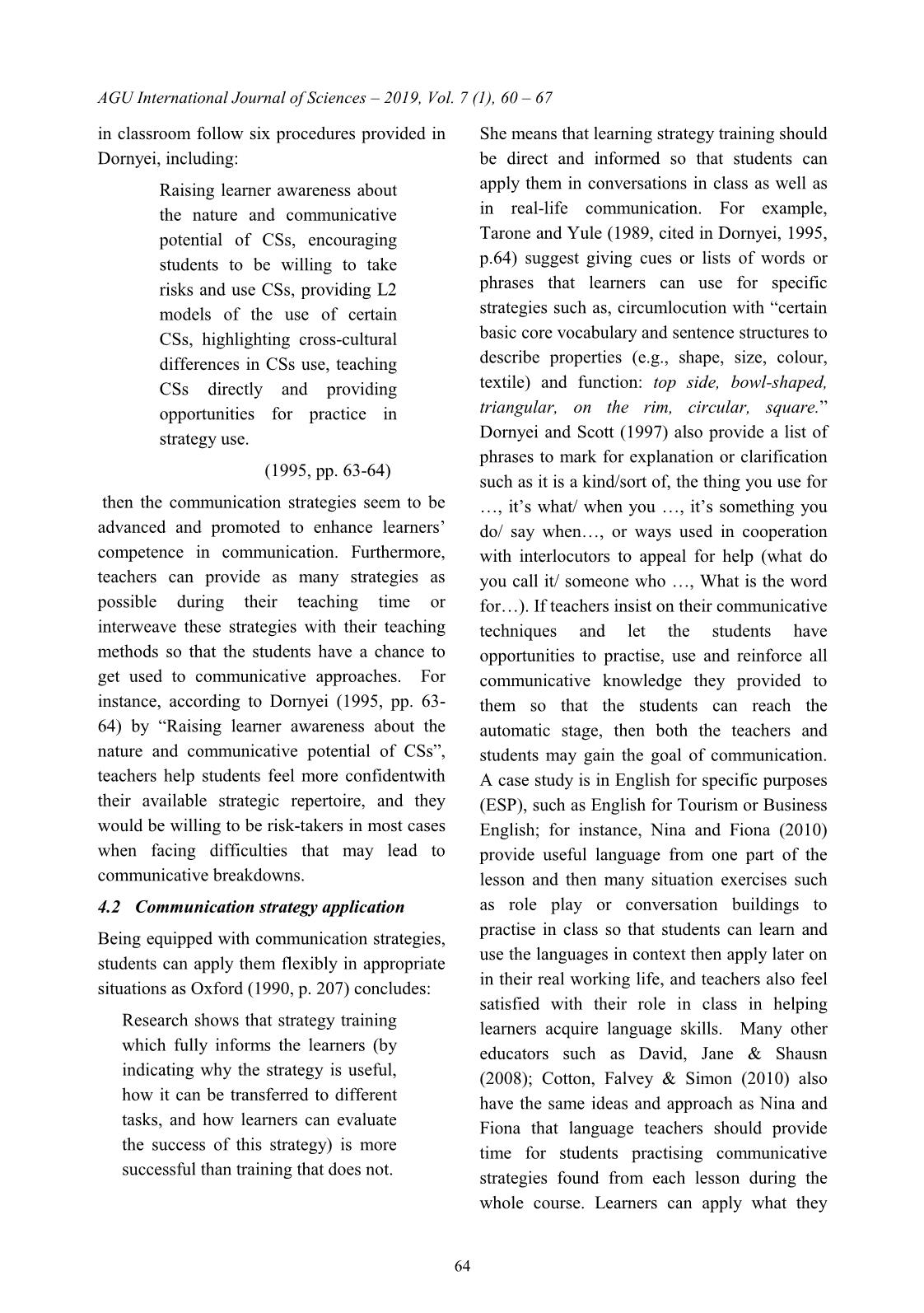
Trang 5
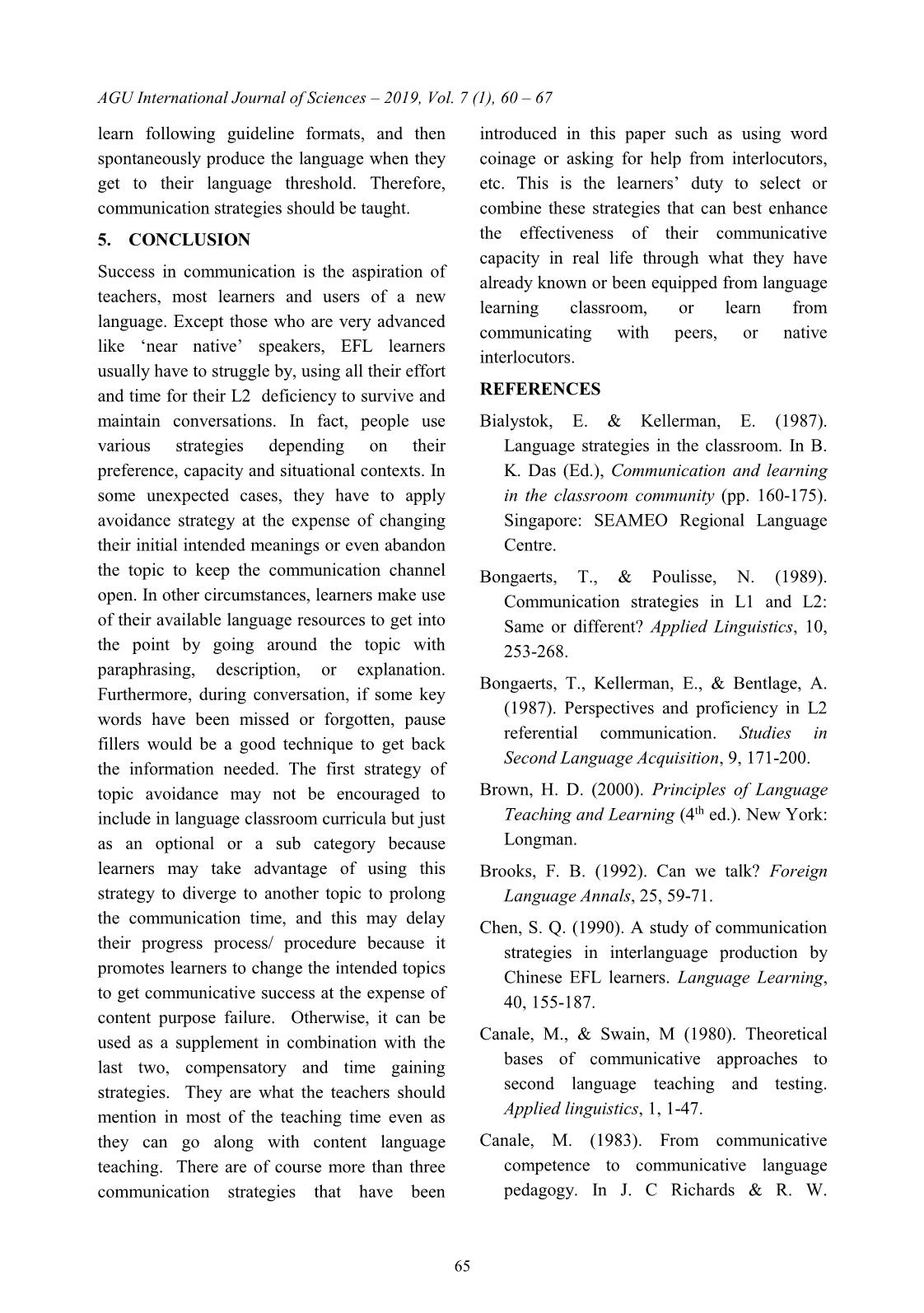
Trang 6
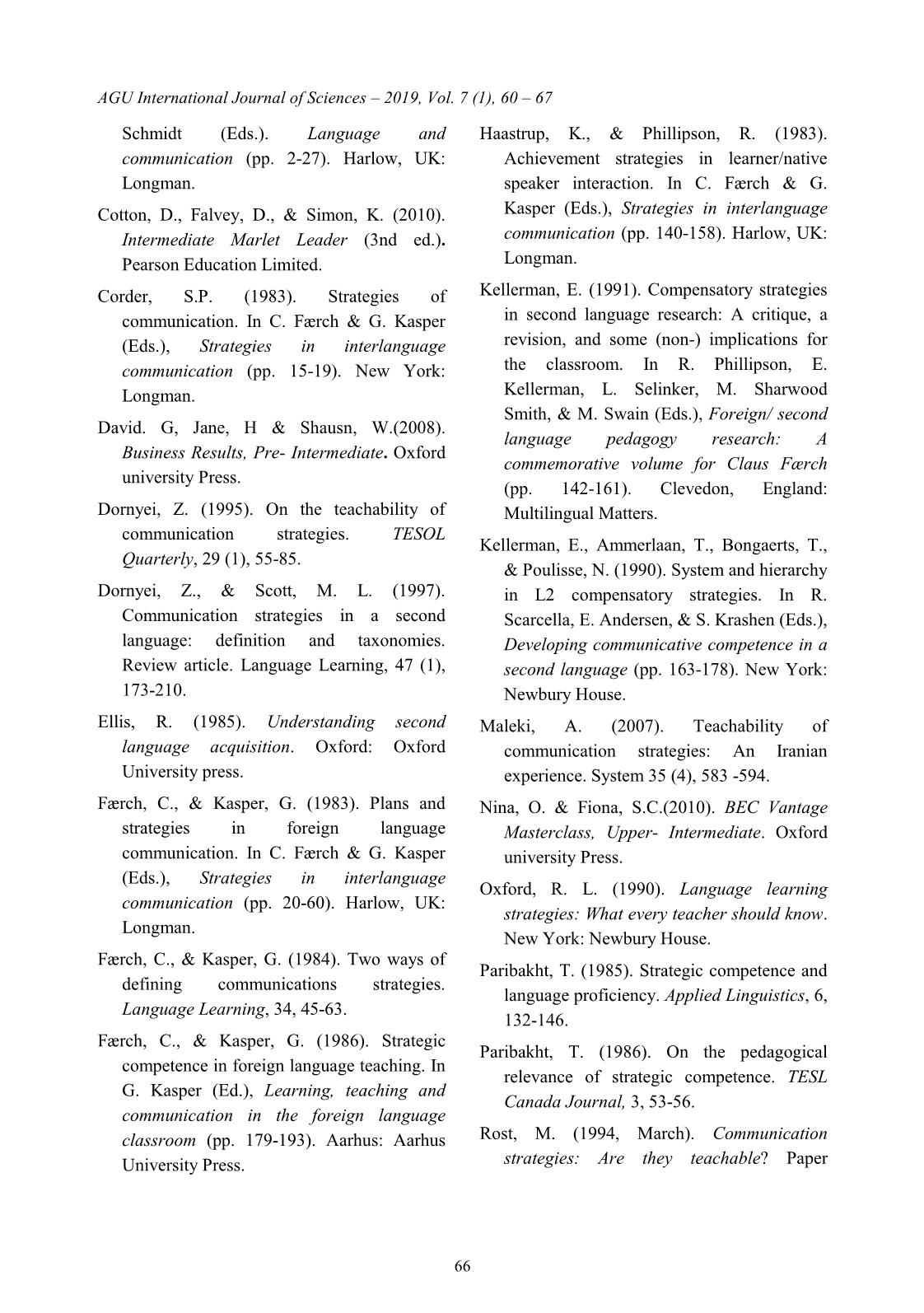
Trang 7
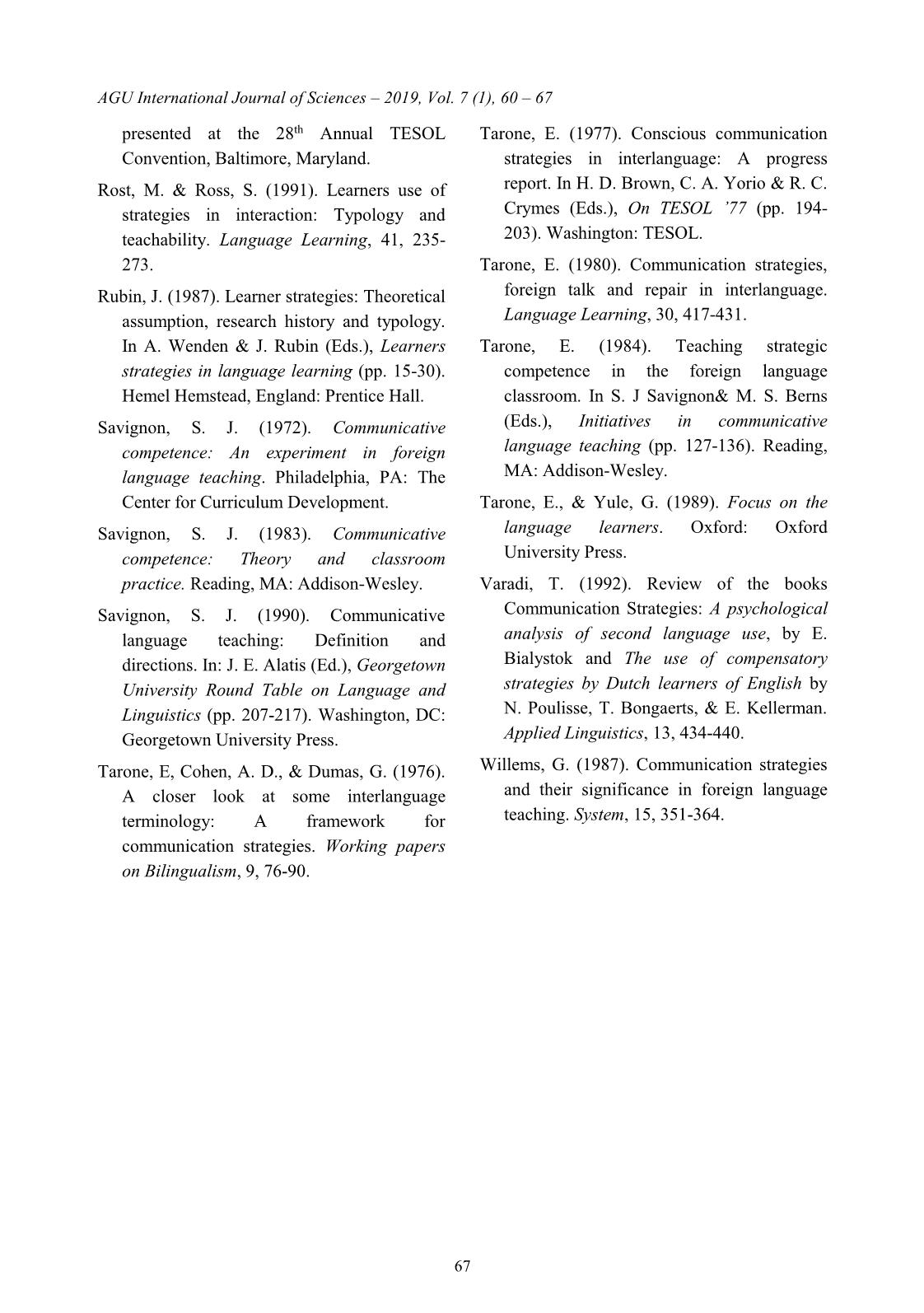
Trang 8
Tóm tắt nội dung tài liệu: Some pertinent oral communication strategies for efl learning and teaching
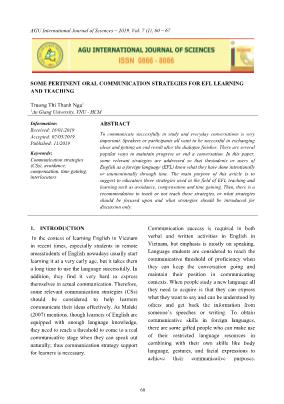
AGU International Journal of Sciences – 2019, Vol. 7 (1), 60 – 67 60 SOME PERTINENT ORAL COMMUNICATION STRATEGIES FOR EFL LEARNING AND TEACHING Truong Thi Thanh Nga1 1An Giang University, VNU - HCM Information: Received: 16/01/2019 Accepted: 02/05/2019 Published: 11/2019 Keywords: Communication strategies (CSs), avoidance, compensation, time gaining, interlocutors ABSTRACT To communicate successfully in study and everyday conversations is very important. Speakers or participants all want to be successful in exchanging ideas and getting an end result after the dialogue finishes. There are several popular ways to maintain progress or end a conversation. In this paper, some relevant strategies are addressed so that thestudents or users of English as a foreign language (EFL) know what they have done intentionally or unintentionally through time. The main purpose of this article is to suggest to educators three strategies used in the field of EFL teaching and learning such as avoidance, compensation and time gaining. Then, there is a recommendation to teach or not teach these strategies, or what strategies should be focused upon and what strategies should be introduced for discussion only. 1. INTRODUCTION In the context of learning English in Vietnam in recent times, especially students in remote areasstudents of English nowadays usually start learning it at a very early age, but it takes them a long time to use the language successfully. In addition, they find it very hard to express themselves in actual communication. Therefore, some relevant communication strategies (CSs) should be considered to help learners communicate their ideas effectively. As Maleki (2007) mentions, though learners of English are equipped with enough language knowledge, they need to reach a threshold to come to a real communicative stage when they can speak out naturally; thus communication strategy support for learners is necessary. Communication success is required in both verbal and written activities in English in Vietnam, but emphasis is mostly on speaking. Language students are considered to reach the communicative threshold of proficiency when they can keep the conversation going and maintain their position in communicating contexts. When people study a new language all they need to acquire is that they can express what they want to say and can be understood by others and get back the information from someone’s speeches or writing. To obtain communicative skills in foreign languages, there are some gifted people who can make use of their restricted language resources in combining with their own skills like body language, gestures, and facial expressions to achieve their communicative purposes. AGU International Journal of Sciences – 2019, Vol. 7 (1), 60 – 67 61 However, there are also strategies that most EFL learners can apply through their life experience or by practising and following some communicative tactics. This paper first reviews definitions of communication strategies, then presents three key communication strategies and finally suggests that communications strategies should be taught. Three pertinent strategies are avoidance, compensation and time gaining. These strategies accompany some tactics which occur at the time of speaking such as topic divergence, circumlocution and using fillers and hesitation devices. The paper first reviews definitions of Communication Strategies and then leads to a discussion about whether communication strategies can be taught or not and their role in EFL teaching. 2. DEFINITION Definitions about communication strategies (CSs) have concerned many linguists. In fact, most linguists in the 1970s and 1980s have concentrated on problem – solving when talking about CSs. For example, Tarone, Cohen and Dumas (1976, p. 5) see “CSs as learners’ systematic attempt to express or decode meaning in the target language”. In a different perspective, Canale and Swain (1980) see CSs as verbal and nonverbal strategies which compensate for breakdowns in communication due to performance variables or insufficient competence in conversations. Tarone (1977) explains that conscious communication strategies are used by an individual to overcome the crisis which occurs when language structures are insufficient to convey the individual’s thought. According to Tarone’s new concept, CSs have been seen as “relate to a mutual attempt of two interlocutors to agree on the meaning in situations where requisite meaning structures do not seem to be shared” (1980, p. 420). It is an interaction perspective rather than meaning- negotiation and repair mechanisms that involve handling difficulties or breakdowns in communications. Corder (1986) also views CSs as speakers’ systematic techniques to express meaning when facing difficulty. However, the broadest definition of CSs is Canale’s (1983) extended concept when he points out that CSs help improve communicative efficiency with various patterns of speech. Therefore, definitions about CSs have been improved through time from problem-solving to meaning negotiation between interlocutors and finally come to enhancing the effectiveness of communication. Among these linguists’ definitions, Corder’s idea about CSs as strategies at the time of the conversation to retain the interaction between the speakers, and then to make the conversation end smoothly, is the basic support of the article. 3. STRATEGIES 3.1 Avoidance strategy Avoidance strategy is mostly used either consciously or unintentionally by non-native speakers when they encounter linguistic problems although its accompanied tactics might not be taught or language learners encouraged to use them. Indeed, people never want to hinder, to hide o ... Phillipson, 1983; Paribakht, 1986; Rost, 1994; Rost & Ross, 1991; Savignon, 1972, 1983, 1990; Tarone, 1984; Tarone and Yule, 1989; Willems, 1987). Therefore, communication strategies that are provided widely and facilitated by the teachers in language classrooms would give students more opportunities to succeed in communication. Tarone (1984) and Willems (1987) cited in Dornyei (1995, p. 62) state ‘There is also some evidence that students in classroom settings which offer more natural input (such as immersion classes) tend to develop a higher level of strategic competence than students in ordinary classrooms, who tend to use only a limited number of mostly unsophisticated CSs.” Therefore, though in any context of learning and teaching EFL, learners should be equipped with enough language, especially useful languages from the stage learners need specific guided and control to free conversations. 4.1 The role of communication in efl language classroom It cannot be denied that most language teachers now want to directly address communication strategies in classrooms although this trend is still debated. This proves that many people perceive that communicative competence is indispensable in language teaching. If teachers AGU International Journal of Sciences – 2019, Vol. 7 (1), 60 – 67 64 in classroom follow six procedures provided in Dornyei, including: Raising learner awareness about the nature and communicative potential of CSs, encouraging students to be willing to take risks and use CSs, providing L2 models of the use of certain CSs, highlighting cross-cultural differences in CSs use, teaching CSs directly and providing opportunities for practice in strategy use. (1995, pp. 63-64) then the communication strategies seem to be advanced and promoted to enhance learners’ competence in communication. Furthermore, teachers can provide as many strategies as possible during their teaching time or interweave these strategies with their teaching methods so that the students have a chance to get used to communicative approaches. For instance, according to Dornyei (1995, pp. 63- 64) by “Raising learner awareness about the nature and communicative potential of CSs”, teachers help students feel more confidentwith their available strategic repertoire, and they would be willing to be risk-takers in most cases when facing difficulties that may lead to communicative breakdowns. 4.2 Communication strategy application Being equipped with communication strategies, students can apply them flexibly in appropriate situations as Oxford (1990, p. 207) concludes: Research shows that strategy training which fully informs the learners (by indicating why the strategy is useful, how it can be transferred to different tasks, and how learners can evaluate the success of this strategy) is more successful than training that does not. She means that learning strategy training should be direct and informed so that students can apply them in conversations in class as well as in real-life communication. For example, Tarone and Yule (1989, cited in Dornyei, 1995, p.64) suggest giving cues or lists of words or phrases that learners can use for specific strategies such as, circumlocution with “certain basic core vocabulary and sentence structures to describe properties (e.g., shape, size, colour, textile) and function: top side, bowl-shaped, triangular, on the rim, circular, square.” Dornyei and Scott (1997) also provide a list of phrases to mark for explanation or clarification such as it is a kind/sort of, the thing you use for , it’s what/ when you , it’s something you do/ say when, or ways used in cooperation with interlocutors to appeal for help (what do you call it/ someone who , What is the word for). If teachers insist on their communicative techniques and let the students have opportunities to practise, use and reinforce all communicative knowledge they provided to them so that the students can reach the automatic stage, then both the teachers and students may gain the goal of communication. A case study is in English for specific purposes (ESP), such as English for Tourism or Business English; for instance, Nina and Fiona (2010) provide useful language from one part of the lesson and then many situation exercises such as role play or conversation buildings to practise in class so that students can learn and use the languages in context then apply later on in their real working life, and teachers also feel satisfied with their role in class in helping learners acquire language skills. Many other educators such as David, Jane & Shausn (2008); Cotton, Falvey & Simon (2010) also have the same ideas and approach as Nina and Fiona that language teachers should provide time for students practising communicative strategies found from each lesson during the whole course. Learners can apply what they AGU International Journal of Sciences – 2019, Vol. 7 (1), 60 – 67 65 learn following guideline formats, and then spontaneously produce the language when they get to their language threshold. Therefore, communication strategies should be taught. 5. CONCLUSION Success in communication is the aspiration of teachers, most learners and users of a new language. Except those who are very advanced like ‘near native’ speakers, EFL learners usually have to struggle by, using all their effort and time for their L2 deficiency to survive and maintain conversations. In fact, people use various strategies depending on their preference, capacity and situational contexts. In some unexpected cases, they have to apply avoidance strategy at the expense of changing their initial intended meanings or even abandon the topic to keep the communication channel open. In other circumstances, learners make use of their available language resources to get into the point by going around the topic with paraphrasing, description, or explanation. Furthermore, during conversation, if some key words have been missed or forgotten, pause fillers would be a good technique to get back the information needed. The first strategy of topic avoidance may not be encouraged to include in language classroom curricula but just as an optional or a sub category because learners may take advantage of using this strategy to diverge to another topic to prolong the communication time, and this may delay their progress process/ procedure because it promotes learners to change the intended topics to get communicative success at the expense of content purpose failure. Otherwise, it can be used as a supplement in combination with the last two, compensatory and time gaining strategies. They are what the teachers should mention in most of the teaching time even as they can go along with content language teaching. There are of course more than three communication strategies that have been introduced in this paper such as using word coinage or asking for help from interlocutors, etc. This is the learners’ duty to select or combine these strategies that can best enhance the effectiveness of their communicative capacity in real life through what they have already known or been equipped from language learning classroom, or learn from communicating with peers, or native interlocutors. REFERENCES Bialystok, E. & Kellerman, E. (1987). Language strategies in the classroom. In B. K. Das (Ed.), Communication and learning in the classroom community (pp. 160-175). Singapore: SEAMEO Regional Language Centre. Bongaerts, T., & Poulisse, N. (1989). Communication strategies in L1 and L2: Same or different? Applied Linguistics, 10, 253-268. Bongaerts, T., Kellerman, E., & Bentlage, A. (1987). Perspectives and proficiency in L2 referential communication. Studies in Second Language Acquisition, 9, 171-200. Brown, H. D. (2000). Principles of Language Teaching and Learning (4th ed.). New York: Longman. Brooks, F. B. (1992). Can we talk? Foreign Language Annals, 25, 59-71. Chen, S. Q. (1990). A study of communication strategies in interlanguage production by Chinese EFL learners. Language Learning, 40, 155-187. Canale, M., & Swain, M (1980). Theoretical bases of communicative approaches to second language teaching and testing. Applied linguistics, 1, 1-47. Canale, M. (1983). From communicative competence to communicative language pedagogy. In J. C Richards & R. W. AGU International Journal of Sciences – 2019, Vol. 7 (1), 60 – 67 66 Schmidt (Eds.). Language and communication (pp. 2-27). Harlow, UK: Longman. Cotton, D., Falvey, D., & Simon, K. (2010). Intermediate Marlet Leader (3nd ed.). Pearson Education Limited. Corder, S.P. (1983). Strategies of communication. In C. Færch & G. Kasper (Eds.), Strategies in interlanguage communication (pp. 15-19). New York: Longman. David. G, Jane, H & Shausn, W.(2008). Business Results, Pre- Intermediate. Oxford university Press. Dornyei, Z. (1995). On the teachability of communication strategies. TESOL Quarterly, 29 (1), 55-85. Dornyei, Z., & Scott, M. L. (1997). Communication strategies in a second language: definition and taxonomies. Review article. Language Learning, 47 (1), 173-210. Ellis, R. (1985). Understanding second language acquisition. Oxford: Oxford University press. Færch, C., & Kasper, G. (1983). Plans and strategies in foreign language communication. In C. Færch & G. Kasper (Eds.), Strategies in interlanguage communication (pp. 20-60). Harlow, UK: Longman. Færch, C., & Kasper, G. (1984). Two ways of defining communications strategies. Language Learning, 34, 45-63. Færch, C., & Kasper, G. (1986). Strategic competence in foreign language teaching. In G. Kasper (Ed.), Learning, teaching and communication in the foreign language classroom (pp. 179-193). Aarhus: Aarhus University Press. Haastrup, K., & Phillipson, R. (1983). Achievement strategies in learner/native speaker interaction. In C. Færch & G. Kasper (Eds.), Strategies in interlanguage communication (pp. 140-158). Harlow, UK: Longman. Kellerman, E. (1991). Compensatory strategies in second language research: A critique, a revision, and some (non-) implications for the classroom. In R. Phillipson, E. Kellerman, L. Selinker, M. Sharwood Smith, & M. Swain (Eds.), Foreign/ second language pedagogy research: A commemorative volume for Claus Færch (pp. 142-161). Clevedon, England: Multilingual Matters. Kellerman, E., Ammerlaan, T., Bongaerts, T., & Poulisse, N. (1990). System and hierarchy in L2 compensatory strategies. In R. Scarcella, E. Andersen, & S. Krashen (Eds.), Developing communicative competence in a second language (pp. 163-178). New York: Newbury House. Maleki, A. (2007). Teachability of communication strategies: An Iranian experience. System 35 (4), 583 -594. Nina, O. & Fiona, S.C.(2010). BEC Vantage Masterclass, Upper- Intermediate. Oxford university Press. Oxford, R. L. (1990). Language learning strategies: What every teacher should know. New York: Newbury House. Paribakht, T. (1985). Strategic competence and language proficiency. Applied Linguistics, 6, 132-146. Paribakht, T. (1986). On the pedagogical relevance of strategic competence. TESL Canada Journal, 3, 53-56. Rost, M. (1994, March). Communication strategies: Are they teachable? Paper AGU International Journal of Sciences – 2019, Vol. 7 (1), 60 – 67 67 presented at the 28th Annual TESOL Convention, Baltimore, Maryland. Rost, M. & Ross, S. (1991). Learners use of strategies in interaction: Typology and teachability. Language Learning, 41, 235- 273. Rubin, J. (1987). Learner strategies: Theoretical assumption, research history and typology. In A. Wenden & J. Rubin (Eds.), Learners strategies in language learning (pp. 15-30). Hemel Hemstead, England: Prentice Hall. Savignon, S. J. (1972). Communicative competence: An experiment in foreign language teaching. Philadelphia, PA: The Center for Curriculum Development. Savignon, S. J. (1983). Communicative competence: Theory and classroom practice. Reading, MA: Addison-Wesley. Savignon, S. J. (1990). Communicative language teaching: Definition and directions. In: J. E. Alatis (Ed.), Georgetown University Round Table on Language and Linguistics (pp. 207-217). Washington, DC: Georgetown University Press. Tarone, E, Cohen, A. D., & Dumas, G. (1976). A closer look at some interlanguage terminology: A framework for communication strategies. Working papers on Bilingualism, 9, 76-90. Tarone, E. (1977). Conscious communication strategies in interlanguage: A progress report. In H. D. Brown, C. A. Yorio & R. C. Crymes (Eds.), On TESOL ’77 (pp. 194- 203). Washington: TESOL. Tarone, E. (1980). Communication strategies, foreign talk and repair in interlanguage. Language Learning, 30, 417-431. Tarone, E. (1984). Teaching strategic competence in the foreign language classroom. In S. J Savignon& M. S. Berns (Eds.), Initiatives in communicative language teaching (pp. 127-136). Reading, MA: Addison-Wesley. Tarone, E., & Yule, G. (1989). Focus on the language learners. Oxford: Oxford University Press. Varadi, T. (1992). Review of the books Communication Strategies: A psychological analysis of second language use, by E. Bialystok and The use of compensatory strategies by Dutch learners of English by N. Poulisse, T. Bongaerts, & E. Kellerman. Applied Linguistics, 13, 434-440. Willems, G. (1987). Communication strategies and their significance in foreign language teaching. System, 15, 351-364.
File đính kèm:
 some_pertinent_oral_communication_strategies_for_efl_learnin.pdf
some_pertinent_oral_communication_strategies_for_efl_learnin.pdf

